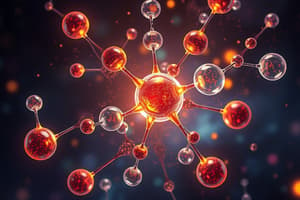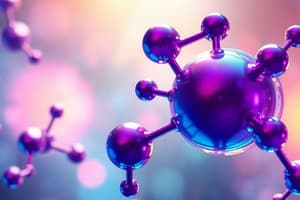Podcast
Questions and Answers
What type of genetic condition is characterized by being an autosomal dominant trait?
What type of genetic condition is characterized by being an autosomal dominant trait?
- Cystic Fibrosis
- Marfan's (correct)
- Tay Sachs
- Hemophilia
Which of these genetic conditions is classified as an autosomal recessive disorder?
Which of these genetic conditions is classified as an autosomal recessive disorder?
- Achondroplasia
- Cystic Fibrosis (correct)
- Polydactyly
- Marfan's
Which outcome of a test cross would indicate that the tall parent corn plant is heterozygous?
Which outcome of a test cross would indicate that the tall parent corn plant is heterozygous?
- The ratio of tall to short offspring is 1:1. (correct)
- All offspring are tall.
- All offspring are short.
- The ratio of tall to short offspring is 3:1.
Which term best describes the phenomenon where one gene influences multiple traits in individuals?
Which term best describes the phenomenon where one gene influences multiple traits in individuals?
Which of the following pedigrees would be consistent with an X-linked recessive pattern of inheritance?
Which of the following pedigrees would be consistent with an X-linked recessive pattern of inheritance?
What is the correct characteristic of cancer cells when compared to normal cells?
What is the correct characteristic of cancer cells when compared to normal cells?
During which stage of meiosis does crossing over occur?
During which stage of meiosis does crossing over occur?
What cellular content is primarily assessed during the different stages of the cell cycle?
What cellular content is primarily assessed during the different stages of the cell cycle?
During which stage of meiosis do homologous chromosomes pair up?
During which stage of meiosis do homologous chromosomes pair up?
Which event is the basis for Mendel's law of independent assortment?
Which event is the basis for Mendel's law of independent assortment?
What percent of a population will be heterozygous carriers for cystic fibrosis in Hardy-Weinberg equilibrium with a recessive allele frequency of 0.6?
What percent of a population will be heterozygous carriers for cystic fibrosis in Hardy-Weinberg equilibrium with a recessive allele frequency of 0.6?
What is the expected phenotype ratio from a cross between a black fur, short tail (BbTt) mouse and a homozygous black, long tail (BBtt) mouse?
What is the expected phenotype ratio from a cross between a black fur, short tail (BbTt) mouse and a homozygous black, long tail (BBtt) mouse?
If two individuals with type AB blood reproduce, what is the probability of having a child with blood type O?
If two individuals with type AB blood reproduce, what is the probability of having a child with blood type O?
In a cross between a black Labrador retriever (BbEe) and a chocolate Lab (bbEe), what is the expected phenotypic ratio of the offspring?
In a cross between a black Labrador retriever (BbEe) and a chocolate Lab (bbEe), what is the expected phenotypic ratio of the offspring?
What is the chance that sons of a male with hemophilia and a heterozygous spouse will have hemophilia?
What is the chance that sons of a male with hemophilia and a heterozygous spouse will have hemophilia?
During which phase does DNA content in a diploid cell reach 4N?
During which phase does DNA content in a diploid cell reach 4N?
What is the characteristic feature of receptor tyrosine kinase activation?
What is the characteristic feature of receptor tyrosine kinase activation?
If the DNA content of a diploid cell in G1 phase is $x$, what is its DNA content at metaphase of meiosis I?
If the DNA content of a diploid cell in G1 phase is $x$, what is its DNA content at metaphase of meiosis I?
Which event occurs immediately after nuclear envelope breakdown during mitosis?
Which event occurs immediately after nuclear envelope breakdown during mitosis?
Which characteristic is NOT typically associated with cancer cells?
Which characteristic is NOT typically associated with cancer cells?
Which of the following occurs in meiosis but not in mitosis?
Which of the following occurs in meiosis but not in mitosis?
In a plant with a diploid chromosome number of $2n=46$, how many pairs of homologous chromosomes are present just after entering Meiosis II?
In a plant with a diploid chromosome number of $2n=46$, how many pairs of homologous chromosomes are present just after entering Meiosis II?
What can be concluded about a woman with two Barr bodies in her karyotype?
What can be concluded about a woman with two Barr bodies in her karyotype?
At which stage of meiosis do cells first become haploid?
At which stage of meiosis do cells first become haploid?
Flashcards
Autosomal recessive condition
Autosomal recessive condition
A genetic disorder where two copies of an abnormal gene are necessary to display the trait, and the gene is located on one of the non-sex chromosomes.
Autosomal dominant condition
Autosomal dominant condition
A genetic disorder where only one copy of an abnormal gene is necessary to display the trait, and the gene is located on one of the non-sex chromosomes.
X-linked condition
X-linked condition
A genetic disorder where the gene is located on the X chromosome.
Test cross
Test cross
Signup and view all the flashcards
Pleiotropy
Pleiotropy
Signup and view all the flashcards
tRNA
tRNA
Signup and view all the flashcards
mRNA codon
mRNA codon
Signup and view all the flashcards
Genotype
Genotype
Signup and view all the flashcards
Homologous chromosomes synapse
Homologous chromosomes synapse
Signup and view all the flashcards
Mendel's Law of Independent Assortment
Mendel's Law of Independent Assortment
Signup and view all the flashcards
Hardy-Weinberg Equilibrium
Hardy-Weinberg Equilibrium
Signup and view all the flashcards
Cystic fibrosis carrier frequency (Hardy-Weinberg)
Cystic fibrosis carrier frequency (Hardy-Weinberg)
Signup and view all the flashcards
Independent Assortment in Meiosis
Independent Assortment in Meiosis
Signup and view all the flashcards
Probability of offspring blood type (AB x AB)
Probability of offspring blood type (AB x AB)
Signup and view all the flashcards
Epistasis example (Labrador retrievers)
Epistasis example (Labrador retrievers)
Signup and view all the flashcards
X-linked recessive trait example
X-linked recessive trait example
Signup and view all the flashcards
Receptor Tyrosine Kinase activation
Receptor Tyrosine Kinase activation
Signup and view all the flashcards
Meiosis I DNA content
Meiosis I DNA content
Signup and view all the flashcards
Mitosis -Next Event
Mitosis -Next Event
Signup and view all the flashcards
Cancer Cell Characteristics
Cancer Cell Characteristics
Signup and view all the flashcards
Meiosis vs. Mitosis
Meiosis vs. Mitosis
Signup and view all the flashcards
Meiosis II Homologous Chromosomes.
Meiosis II Homologous Chromosomes.
Signup and view all the flashcards
Barr Bodies and Karyotypes
Barr Bodies and Karyotypes
Signup and view all the flashcards
Meiosis Cell Becoming Haploid
Meiosis Cell Becoming Haploid
Signup and view all the flashcards
Study Notes
K101 Final Exam Study Guide
- The final exam will consist of 90 questions.
- 50 questions are worth 2 points each.
- 40 questions are worth 1 point each.
- A total of 140 points.
- Students are encouraged to work in teams to determine the correct answers.
Unit 1: The Chemistry of Life -> Ch. 4 – Organic Molecules
-
Water molecule bonds: Polar covalent bonds connect hydrogen to oxygen.
-
Stanley Miller's 1953 experiments: Demonstrated the abiotic synthesis of organic molecules under early Earth conditions.
-
Four elements of life (carbon, oxygen, hydrogen, and nitrogen): Have the same number of valence electrons and are essential to life.
-
Functional groups: Specific groups of atoms with characteristic chemical reactions.
-
Examples of functional groups and their descriptions are provided in the document.
Ch. 5 - Macromolecules
- Fatty acid modifications for solid triglycerides at warmer temperatures: Adding hydrogen atoms and trans double bonds.
Studying That Suits You
Use AI to generate personalized quizzes and flashcards to suit your learning preferences.




